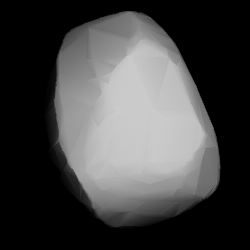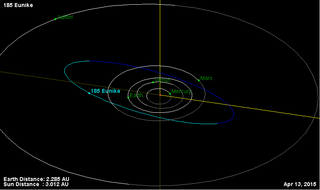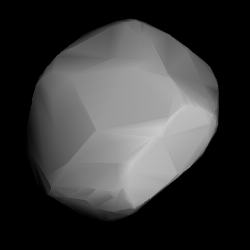
Isis, minor planet designation: 42 Isis, is a large main-belt asteroid, measuring 100.2 km in diameter with a stony (S-type) composition. It was discovered by English astronomer N.R. Pogson on 23 May 1856 at Oxford, and was his first asteroid discovery. The asteroid's name was chosen by Manuel John Johnson, director of the Radcliffe Observatory in Oxford. Although Isis is the name of an Egyptian goddess, the name was chosen in homage to Pogson's astronomer daughter, (Elizabeth) Isis Pogson. In addition, the Isis is the stretch of the River Thames that runs through Oxford.

Lachesis is a large main-belt asteroid. It was discovered by French astronomer Alphonse Borrelly on April 10, 1872, and independently by German-American astronomer Christian Heinrich Friedrich Peters on April 11, 1872, then named after Lachesis, one of the Moirai, or Fates, in Greek mythology. A Lachesean occultation of a star occurred in 1999 and was confirmed visually by five observers and once photoelectrically, with the chords yielding an estimated elliptical cross-section of 184 × 144 km.

Sophrosyne is a large main-belt asteroid that was discovered by German astronomer Robert Luther on 27 September 1873, and was named after the concept of sophrosyne, Plato's term for 'moderation'. Classified as a C-type asteroid, it has an exceedingly dark surface and most probably a primitive carbonaceous composition.

Hertha is an asteroid from the inner region of the asteroid belt, approximately 77 kilometers in diameter. Discovered on 18 February 1874 by German–American astronomer Christian Peters at the Litchfield Observatory near Clinton, New York, it was named after the Teutonic and Scandinavian goddess of fertility, Hertha, also known as Nerthus. It orbits among the Nysa asteroid family, but its classification as a metallic M-type asteroid does not match the more common F-type asteroid for this family, suggesting that it may be an interloper. Spectroscopic analysis indicates the possible presence of hydrated silicates indicating that Hertha should possibly be reclassified from its present M-type to the proposed W-type.

161 Athor is an M-type Main belt asteroid that was discovered by James Craig Watson on April 19, 1876, at the Detroit Observatory and named after Hathor, an Egyptian fertility goddess. It is the namesake of a proposed Athor asteroid family, estimated to be ~3 billion years old.

164 Eva is a main-belt asteroid that was discovered by the French brothers Paul Henry and Prosper Henry on July 12, 1876, in Paris. The reason the name Eva was chosen remains unknown, though Karl Ludwig Littrow suspected a "worldly origin". The orbital elements for 164 Eva were published in 1877 by American astronomer Winslow Upton. It is categorized as a C-type asteroid and is probably composed of primitive carbonaceous chondritic materials.

Eunike is a dark and very large main-belt asteroid, with an approximate diameter of 157 kilometres. It has a primitive carbonaceous composition.

Prokne is a main-belt asteroid that was discovered by German-American astronomer C. H. F. Peters on March 21, 1879, in Clinton, New York, and named after Procne, the sister of Philomela in Greek mythology. Stellar occultations by Prokne have been observed twice, in 1984 from Italy and again in 1999 from Iowa.

Dynamene is a large dark main-belt asteroid that was discovered by German-American astronomer Christian Heinrich Friedrich Peters on July 27, 1879, in Clinton, New York. The name derives from Dynamene, one of the fifty Nereids in Greek mythology. Based upon its spectrum, 200 Dynamene is classified as a C-type asteroid, indicating that it probably has a primitive composition similar to the carbonaceous chondrite meteorites. The spectra of the asteroid displays evidence of aqueous alteration.

Hypatia is a very large main-belt asteroid that was discovered by Russian astronomer Viktor Knorre on July 1, 1884, in Berlin. It was the third of his four asteroid discoveries. The name was given in honour of philosopher Hypatia of Alexandria. Based upon the spectrum, it is classified as a C-type asteroid and is probably composed of primitive carbonaceous material. Like many asteroids of this type, its surface is very dark in colour.

Vanadis is a fairly large main-belt asteroid with a diameter of around 100 km. It was discovered by A. Borrelly on August 27, 1884, in Marseilles and was named after Freyja (Vanadis), the Norse fertility goddess. The asteroid is orbiting the Sun at a distance of 2.67 AU with a period of 4.35 yr and an orbital eccentricity of 0.206. The orbital plane is inclined at an angle of 2.10° to the plane of the ecliptic.

Myrrha is a main-belt asteroid that was discovered by the French astronomer Auguste Charlois on January 10, 1894, in Nice. It has been classified as a C-type asteroid and is most likely composed of carbonaceous material.
Franziska, provisional designation 1903 MV, is an Eoan asteroid from the outer regions of the asteroid belt, approximately 27 kilometers in diameter. It was discovered on 27 October 1903, by astronomers Max Wolf and Paul Götz at the Heidelberg-Königstuhl State Observatory in southwest Germany. The origin of the asteroid's name is unknown.
Herodias is a carbonaceous asteroid from the central regions of the asteroid belt, approximately 66 kilometers in diameter. It is an identified Eunomian interloper. It was named after the biblical character Herodias.
735 Marghanna is a large carbonaceous background asteroid from the central regions of the asteroid belt, approximately 74 kilometers in diameter. It was discovered on 9 December 1912, by German astronomer Heinrich Vogt at the Heidelberg-Königstuhl State Observatory in southwest Germany. The dark C-type asteroid (Ch) has a rotation period of 20.6 hours and is rather regular in shape. It was named after Margarete Vogt and after Hanna, the mother and a relative of the discoverer, respectively.

791 Ani is a very large asteroid of the Meliboea family, located in the outer regions of the asteroid belt. It was discovered on 29 June 1914, by Russian astronomer Grigory Neujmin at the Simeiz Observatory on the Crimean peninsula. The dark carbonaceous C-type asteroid has a rotation period of 11.2 hours and measures approximately 65.7 × 103.5 kilometers, with a mean-diameter of 100 km (62 mi). It was named after the historic Armenian city of Ani.

867 Kovacia is an elongated, dark asteroid and member of the Hygiea family from the outer regions of the asteroid belt. It was discovered on 25 February 1917, by astronomer Johann Palisa at the Vienna Observatory in Austria. The carbonaceous C/B-type asteroid has a rotation period of 8.7 hours and measures approximately 24 kilometers in diameter. It was named after Austrian physician Friedrich Kovacs (1861–1931).
977 Philippa is a large background asteroid from the outer regions of the asteroid belt, approximately 65 kilometers in diameter. It was discovered on 6 April 1922, by Russian–French astronomer Benjamin Jekhowsky at the Algiers Observatory in Northern Africa. The C-type asteroid is likely irregular in shape and has a rotation period of 15.4 hours. It was named after French financier Baron Philippe de Rothschild (1902–1988).

1017 Jacqueline is a dark background asteroid from the central regions of the asteroid belt. It was discovered on 4 February 1924, by Russian-French astronomer Benjamin Jekhowsky at the Algiers Observatory, Algeria, in North Africa. The carbonaceous C-type asteroid has a rotation period of 7.87 hours with a high brightness amplitude of 0.6 magnitude and measures approximately 39 kilometers in diameter. It was named after the French physicist and long-time pupil of the discoverer, Jacqueline Zadoc-Kahn Eisenmann (1904–1998).
11573 Helmholtz, provisional designation 1993 SK3, is a Zhongguo asteroid from the outermost region of the asteroid belt, approximately 13 kilometers (8 miles) in diameter. It was discovered on 20 September 1993, by German astronomers Freimut Börngen and Lutz Schmadel at the Karl Schwarzschild Observatory in Tautenburg, Germany. It is one of few asteroids located in the 2:1 resonance with Jupiter. The asteroid was named for German physicist Hermann von Helmholtz.















